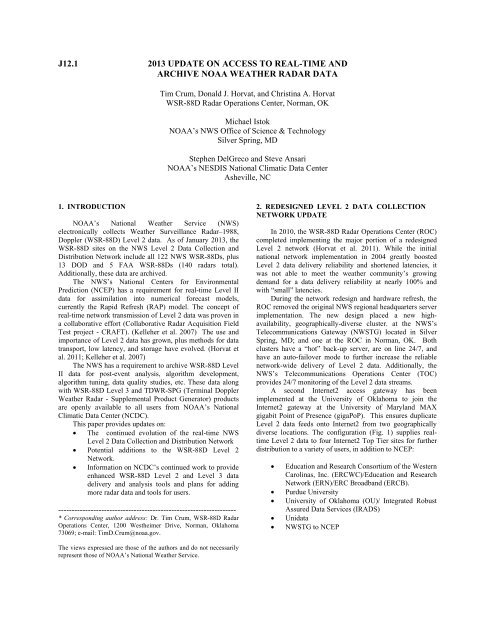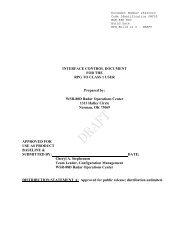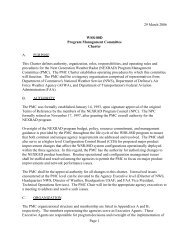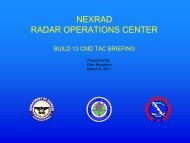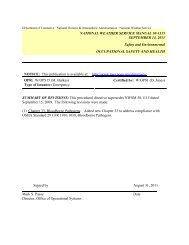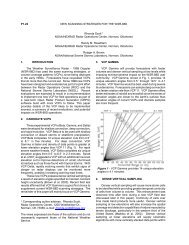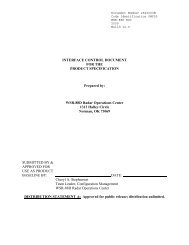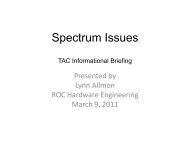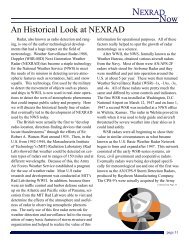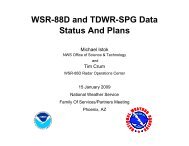Download Here - NEXRAD Radar Operations Center - NOAA
Download Here - NEXRAD Radar Operations Center - NOAA
Download Here - NEXRAD Radar Operations Center - NOAA
Create successful ePaper yourself
Turn your PDF publications into a flip-book with our unique Google optimized e-Paper software.
J12.1 2013 UPDATE ON ACCESS TO REAL-TIME ANDARCHIVE <strong>NOAA</strong> WEATHER RADAR DATATim Crum, Donald J. Horvat, and Christina A. HorvatWSR-88D <strong>Radar</strong> <strong>Operations</strong> <strong>Center</strong>, Norman, OKMichael Istok<strong>NOAA</strong>’s NWS Office of Science & TechnologySilver Spring, MDStephen DelGreco and Steve Ansari<strong>NOAA</strong>’s NESDIS National Climatic Data <strong>Center</strong>Asheville, NC1. INTRODUCTION<strong>NOAA</strong>’s National Weather Service (NWS)electronically collects Weather Surveillance <strong>Radar</strong>–1988,Doppler (WSR-88D) Level 2 data. As of January 2013, theWSR-88D sites on the NWS Level 2 Data Collection andDistribution Network include all 122 NWS WSR-88Ds, plus13 DOD and 5 FAA WSR-88Ds (140 radars total).Additionally, these data are archived.The NWS’s National <strong>Center</strong>s for EnvironmentalPrediction (NCEP) has a requirement for real-time Level IIdata for assimilation into numerical forecast models,currently the Rapid Refresh (RAP) model. The concept ofreal-time network transmission of Level 2 data was proven ina collaborative effort (Collaborative <strong>Radar</strong> Acquisition FieldTest project - CRAFT). (Kelleher et al. 2007) The use andimportance of Level 2 data has grown, plus methods for datatransport, low latency, and storage have evolved. (Horvat etal. 2011; Kelleher et al. 2007)The NWS has a requirement to archive WSR-88D LevelII data for post-event analysis, algorithm development,algorithm tuning, data quality studies, etc. These data alongwith WSR-88D Level 3 and TDWR-SPG (Terminal DopplerWeather <strong>Radar</strong> - Supplemental Product Generator) productsare openly available to all users from <strong>NOAA</strong>’s NationalClimatic Data <strong>Center</strong> (NCDC).This paper provides updates on: The continued evolution of the real-time NWSLevel 2 Data Collection and Distribution Network Potential additions to the WSR-88D Level 2Network. Information on NCDC’s continued work to provideenhanced WSR-88D Level 2 and Level 3 datadelivery and analysis tools and plans for addingmore radar data and tools for users.------------------------------------------------------------------* Corresponding author address: Dr. Tim Crum, WSR-88D <strong>Radar</strong><strong>Operations</strong> <strong>Center</strong>, 1200 Westheimer Drive, Norman, Oklahoma73069; e-mail: TimD.Crum@noaa.gov.2. REDESIGNED LEVEL 2 DATA COLLECTIONNETWORK UPDATEIn 2010, the WSR-88D <strong>Radar</strong> <strong>Operations</strong> <strong>Center</strong> (ROC)completed implementing the major portion of a redesignedLevel 2 network (Horvat et al. 2011). While the initialnational network implementation in 2004 greatly boostedLevel 2 data delivery reliability and shortened latencies, itwas not able to meet the weather community’s growingdemand for a data delivery reliability at nearly 100% andwith “small” latencies.During the network redesign and hardware refresh, theROC removed the original NWS regional headquarters serverimplementation. The new design placed a new highavailability,geographically-diverse cluster. at the NWS’sTelecommunications Gateway (NWSTG) located in SilverSpring, MD; and one at the ROC in Norman, OK. Bothclusters have a “hot” back-up server, are on line 24/7, andhave an auto-failover mode to further increase the reliablenetwork-wide delivery of Level 2 data. Additionally, theNWS’s Telecommunications <strong>Operations</strong> <strong>Center</strong> (TOC)provides 24/7 monitoring of the Level 2 data streams.A second Internet2 access gateway has beenimplemented at the University of Oklahoma to join theInternet2 gateway at the University of Maryland MAXgigabit Point of Presence (gigaPoP). This ensures duplicateLevel 2 data feeds onto Internet2 from two geographicallydiverse locations. The configuration (Fig. 1) supplies realtimeLevel 2 data to four Internet2 Top Tier sites for furtherdistribution to a variety of users, in addition to NCEP:Education and Research Consortium of the WesternCarolinas, Inc. (ERCWC)/Education and ResearchNetwork (ERN)/ERC Broadband (ERCB).Purdue UniversityUniversity of Oklahoma (OU)/ Integrated RobustAssured Data Services (IRADS)UnidataNWSTG to NCEPThe views expressed are those of the authors and do not necessarilyrepresent those of <strong>NOAA</strong>’s National Weather Service.
Fig. 1. Schematic of the refreshed NWS Level II Data Collection and Distribution Network as of January 2013. WSR-88D Level II data flows from radar sites, left side of figure, via the OPSnet “cloud” to two national clusters/aggregationpoints: primary at the NWS Telecommunications Gateway (NWSTG) and backup at the WSR-88D <strong>Radar</strong> <strong>Operations</strong><strong>Center</strong> (ROC). The NWS sends Level II data to NWS National <strong>Center</strong>s for Environmental Prediction, two separateInternet2 gigabit Point of Presence (gigaPops) for further distribution to the four Internet2 Top Tiers, and on to a widevariety of Level II users.3. LEVEL 2 DATA CHANGESLevel 2 data users need to be aware of, and plan forfuture changes to the Level 2 data stream content, increaseddata rates, and required bandwidth. These improvements arescheduled to continue through 2014. Sources of the addedbandwidth and estimated data rate changes follow.3.1 Level 2 Data Stream ChangesAs WSR-88Ds are modified for dual polarization(ending in June 2013), three dual polarization variables areadded to the legacy/single polarization three base moments inthe Level 2 data stream (Crum et al. 2013). This addedcapability/data approximately doubles the amount of Level 2data transmitted from the network’s radars.In early 2014, a new, dynamic scanning method calledthe Supplemental Adaptive Intra-Volume Low-Level Scan(SAILS) will be introduced in Build 14. SAILS inserts onesupplemental “Split Cut” scan, normally 0.5°, into existingsevere weather volume coverage patterns (VCPs) 12 and 212.This additional Split Cut scan is inserted into the “middle” ofthe volume scan to evenly space the time intervals betweenlow-level data updates. SAILS, like the recently-reintroducedAutomated Volume Scan Evaluation and Termination(AVSET) function, is operator-controlled and will notoperate continuously. The ROC estimates the combination ofSAILS and AVSET (when the operators select their use) willincrease a radar’s Level2 data flow 25%, beyond that addedby the dual polarization modification. More information onSAILS and AVSET is available at:http://www.roc.noaa.gov/WSR88D/New<strong>Radar</strong>Technology/NewTechDefault.aspx- 2 -
3.2 Additional Level 2 Sites on the NetworkThe NWS plans to add the eight remaining Air ForceWSR-88Ds in the “lower 48”states to the Level 2 DataCollection and Distribution Network by mid-2013. Addingthe seven FAA WSR-88Ds in Alaska and the Air ForceWSR-88D in Guam are dependent on future communicationsbandwidth needs and availability of funding.4. LEVEL 3 DATA CHANGESAs with Level 2 data, users of Level 3 products need tobe aware of and plan for future changes in Level 3 datastreams for the same reasons listed above for Level 2. Theaddition of dual polarization at a network site adds 15products to the NWS’s <strong>Radar</strong> Product Central CollectionDissemination Service (RPCCDS).We are often asked how the Level 2 and Level 3 data aresent from the radar to users. We have prepared Fig. 2 and Fig.3 to help readers understand the data paths’ architecture.3025201510501991Level 2 & 3 Data AnnuallyArchived at NCDC199319951997Level‐3 (TB)Level‐2 (TB)19992001200320052007200920115. NATIONAL CLIMATIC DATA CENTER (NCDC)The NCDC has done an outstanding job supporting theNWS’s WSR-88D Level 2 and Level 3 data archiverequirements since 1993. The NCDC has also servedgrowing user data demands as seen in the next two sections.5.1 Archived WSR-88D Level 2 and Level 3 DataWe described the increased WSR-88D data rates inSections 3 and 4 above; and these data also go to NCDC. Ifthe NWS collects it, the NCDC archives it and makes itavailable to requestors.The amount of Level 2 and Level 3 data archived peryear is shown in (Fig. 3). The amount of Level 3 dataarchived increased six‐fold from 2008 to 2012. This is dueto the addition of legacy products and dual polarizationWSR-88D products to the NWS Central Data Collection datastream and the addition of TDWR-SPG products from 45sites.Additionally, the amount of archived Level 2 and Level3 data ordered/accessed more than doubled between 2011 and2012 (Fig. 4). We attribute the large annual increases in dataordering, since 2008, to the user community’s increasedapplications for these data and ease of manipulating the data.In 2012, the email domains of archive Level 2 requestorswere: 27% .gov; 29% .edu; 1% .mil; and 43% “other.” Themedian Level 2 user-request retrieval latency was ~6 min. in2011.5.2 Display Tools for WSR-88D Archived Data UsersThe NCDC continues to expand the capability of theWeather and Climate Toolkit (WCT) to support userexploration of WSR-88D archive data and other weather andclimate data types, including satellite and model data. TheWCT is platform-independent software available from theNCDC at no charge. The WCT allows the visualization andexport of data. By leveraging the NetCDF for Java libraryand Common Data Model, the WCT is scalable and capableof supporting many new datasets. Gridded NetCDF filesFig. 3. Annual amounts of Level 2 and Level 3 dataarchived at NCDC since collection began in 1993.20015010050Fig. 4. Annual amounts of Level 2 and Level 3 data usersrequested and NCDC provided the last 11 years.(using Climate-Forecast (CF) conventions) are supported,along with many other formats. The WCT provides tools forcustom data overlays, Web Map Service (WMS) backgroundmaps, animations and basic filtering. Fig. 5 and Fig. 6 areexample images of how the WCT can depict radar data andincrease user understanding and use of the data.The NCDC has plans for further enhanced WCTcapabilities. An example is in Fig. 6. A short listing ofpossible additions includes:0Level 2 & 3 Data AnnuallyAccessed from NCDCLevel‐3 (TB)Level‐2 (TB)20022003200420052006200720082009201020112012Improved Point and Time Series (station data)support,Comparison between station data and grid/radialdata,Enhance Time Morphing features,Batch / Command-line KMZ export; and,- 3 -
Enhanced integration with the Climate Servicesportal (http://www.climate.gov)5.2 NCDC Weather <strong>Radar</strong> GoalsThe NCDC vision for radar data services is to stay onthe leading-edge of user friendly visualization and dataconversion tools. In addition, the NCDC is exploring how tomanage radar data sets that are even larger than the WSR-88D Level 2 while reaching out to other countries to providea similar service for their radar data sets.6. ACKNOWLEGEMENTSThe NWS TOC provides real-time operational supportand monitoring of the Level II network.Real-time Level 2 data distribution to external users isprovided by the Level 2 Top Tiers at the University ofOklahoma/Integrated Robust Assured Data Services(IRADS), Purdue University, and The Education andResearch Consortium of the Western Carolinas, Inc.(ERCWC)/Education and Research Network (ERN)/ERCBroadband (ERCB). The points of contact for the abovelistedthree Top Tiers are available at:http://www.roc.noaa.gov/WSR88D/PublicDocs/Level_II/TopTier_PointsOfContact0112.pdf. Unidata serves as a Top Tierfor their member universities.It is of interest to note that what started as acollaborative effort with the Project CRAFT (Collaborative<strong>Radar</strong> Acquisition Field Test) in the late 1990s continues tothrive and progress as a collaborative effort.7. REFERENCESAnsari, S. et al, 2012: The Weather and Climate Toolkit:2012. 28 th Conf. on Interactive Information andProcessing Systems, New Orleans, LA, Amer. Meteor.Soc., Paper 5A.1Crum, T. et al, 2013: WSR-88D <strong>Radar</strong> Projects: 2013Update. 29 th Conf. on Environmental InformationProcessing Technologies, Austin, TX, Amer. Meteor.Soc., Paper 8.1.Crum, T. et al, 2010: NWS WSR-88D and TDWR-SPG datacollection and distribution network status and plans.26th Conf. on Interactive Information and ProcessingSystems, Atlanta, GA, Amer. Meteor. Soc., Paper 4.6.Horvat, D. et al, 2011: The Refreshed WSR-88D Level IIData Collection and Distribution Network. 27th Conf.on Interactive Information and Processing Systems,Seattle, WA, Amer. Meteor. Soc., Paper 3A.1.Kelleher, K. E., and Coauthors, 2007: Project CRAFT: Areal-time delivery system for <strong>NEXRAD</strong> Level II datavia the Internet. Bull. Amer. Meteor. Soc., 88, 1045-1057.Fig. 2. Depiction of the flow of WSR-88D Level 2 and Level 3 data from a WSR-88D to NWS distributioncenters for further transmission to users.- 4 -
Fig. 5. Sample image of WSR-88D Level 2 Reflectivity for Hurricane Charley (2004), created by the Weather andClimate Toolkit (WCT) available for free download from NCDC.Fig. 6. Example WSR-88D reflectivity data from all scans angles from the KTBW (Tampa, FL) WSR-88D, exportedfrom the WTC as a 3D-enabled KMZ file and visualized on Google Earth.- 5 -
Fig.7. Screen capture of a new WCT tool that manipulates the WSR-88D Level 2 data and can perform simpleanalysis functions on a series of files.8. RELATED WEB SITES/USEFUL RESOURCES Federal Meteorological Handbook No.11 (FMH-11): http://www.ofcm.gov/homepage/text/pubs.htm WSR-88D Dual Polarization training materials: http://www.wdtb.noaa.gov/ ERC Real-Time Level II Data Monitoring Site: http://www.ercbroadband.org/index.php/level-ii-data-status NWS Real-Time Level II Data Monitoring Site: http://weather.noaa.gov/monitor/radar2/ NWS Real-Time Level 3 Product Site Status: http://weather.noaa.gov/monitor/radar3/ NWS <strong>Radar</strong> Product Central Collection Dissemination Service: http://www.nws.noaa.gov/tg/rpccds.html NCDC <strong>Radar</strong> Archive Data: http://www.ncdc.noaa.gov/oa/radar/radarresources.html WSR-88D Common <strong>Operations</strong> and Development Environment: http://www.weather.gov/code88d/ WSR-88D <strong>Radar</strong> <strong>Operations</strong> <strong>Center</strong>- Home Page: http://www.roc.noaa.gov/WSR88D/- Interface Control Documents: http://www.roc.noaa.gov/WSR88D/Program/ICDs.aspx- Level II/Base Data Information: http://www.roc.noaa.gov/WSR88D/Level_II/Level2Info.aspx- Level III/Product Information: http://www.roc.noaa.gov/WSR88D/Level_III/Level3Info.aspx <strong>NOAA</strong> Earth System Research Laboratory: http://www.esrl.noaa.gov/research/themes/regional/- 6 -


